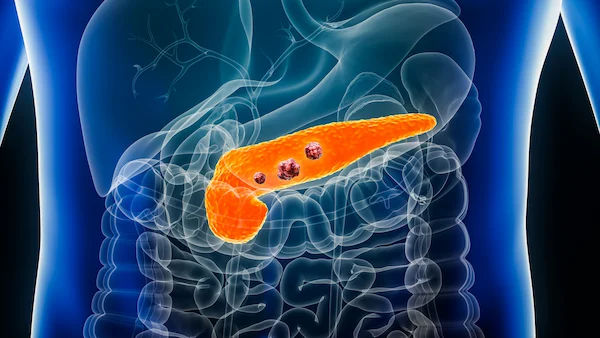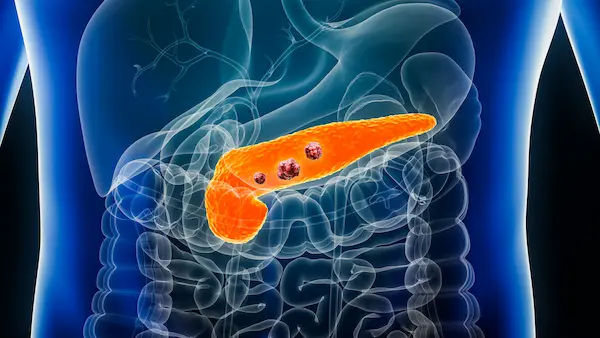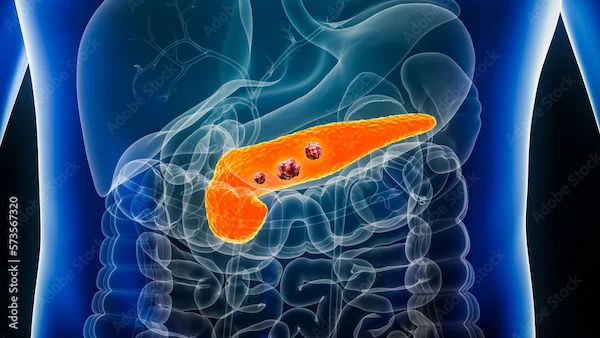Managing Pancreatic Cancer Pain: A Comprehensive Guide for Patients and Families
Know about the pancreatic cancer pain, why it leads to pain, communication of pain and basic medications and advanced interventions for pancreatic pain management.

Written by Dr. Rohinipriyanka Pondugula
Reviewed by Dr. Vasanthasree Nair MBBS
Last updated on 7th Oct, 2025
.webp?tr=q-80,f-webp,w-350,dpr-2,c-at_max 700w)
Introduction
Living with pancreatic cancer presents numerous challenges, and pain is often one of the most daunting. This pain can be complex, varying from a dull ache to a sharp, burning sensation, and it can significantly impact your quality of life. However, it is crucial to know that pancreatic cancer pain is manageable. You do not have to suffer in silence. This guide is designed to empower you and your loved ones with a clear understanding of the causes of pain and the wide array of effective strategies available to control it. From over-the-counter options to advanced medical procedures and supportive therapies, we will walk you through a holistic approach to pain management. Our goal is to help you reclaim comfort and focus on what matters most.
Why Does Pancreatic Cancer Cause Pain?
Understanding the source of your pain is the first step toward managing it effectively. Pancreatic cancer pain isn't a single experience; it arises from different mechanisms related to the tumour's location and behaviour.
Consult an Oncologist for Personalised Advice
Tumour Pressure and Abdominal Pain
The pancreas is located deep in the abdomen, behind the stomach and near the bile duct and small intestine. As a tumour grows, it can press against surrounding organs, nerves, and blood vessels. This pressure often manifests as a persistent, gnawing pain in the upper abdomen that may radiate towards the back. It can also block the bile duct or intestine, leading to jaundice, nausea, and more severe cramping or discomfort.
Nerve Involvement and Back Pain
One of the most characteristic features of pancreatic cancer pain is its tendency to cause significant back pain. This happens because the pancreas is located close to a complex network of nerves called the celiac plexus. When a tumour invades or irritates these nerves, it can cause severe, relentless pain in the mid-back. This type of nerve-related pain, known as neuropathic pain, can be burning or shooting in nature and may not always respond perfectly to standard painkillers, requiring specialised treatments.
Pain from Cancer Treatments
It's important to recognise that pain can also be a side effect of treatments like surgery (e.g., Whipple procedure), chemotherapy, or radiation. Post-surgical pain is common but can be managed, while some chemotherapies can cause nerve damage (peripheral neuropathy) in the hands and feet. Communicating these new or changing pains to your oncology team is essential so they can adjust your treatment or pain management plan accordingly.
The First Step: Communicating Your Pain Effectively
Your healthcare team relies on you to be their eyes and ears. Accurate communication is the cornerstone of effective pain management. Being vague ("I'm in pain") is less helpful than providing specific details.
Using a Pain Scale and Pain Diary
Doctors often use a pain scale from 0 (no pain) to 10 (the worst pain imaginable). Get familiar with this scale and use it consistently. Even more powerful is keeping a simple "pain diary." Note down:
Location: Where is the pain? (e.g., upper abdomen, mid-back).
Intensity: Rate it from 0-10.
Quality: What does it feel like? (e.g., stabbing, aching, burning, pressure).
Timing: When does it start? How long does it last?
Triggers/Alleviators: Does anything make it better or worse (e.g., eating, certain positions, medication)?
This diary provides your doctor with objective data to make informed decisions about your care. If tracking your symptoms feels overwhelming, consider discussing them with a specialist online. Platforms like Apollo24|7 allow you to consult with an oncologist or palliative care doctor from home, who can help you organise this information before an in-person visit.
Medical Management: The Pain Relief Ladder
The World Health Organisation (WHO) analgesic ladder provides a structured approach to cancer pain management. The goal is to use the simplest effective treatments first and escalate as needed.
Over-the-Counter and Mild Pain Relievers
For mild pain, may recommend non-opioid medications like acetaminophen (Tylenol) or nonsteroidal anti-inflammatory drugs (NSAIDs) like ibuprofen. However, these must be used with caution and under strict medical supervision, as NSAIDs can increase the risk of bleeding, and acetaminophen can affect the liver—especially if your liver function is already compromised.
The Role of Opioid Medications
For moderate to severe pancreatic cancer pain, opioids are the mainstay of treatment. Medications like morphine, oxycodone, fentanyl, and hydromorphone are highly effective. A common misconception is that opioids should only be used at the very end of life, but this is not true. When used correctly under a doctor's guidance, they are safe and essential for maintaining quality of life. The key is finding the right drug and dose to control pain with minimal side effects.
Managing Side Effects of Pain Medication
Fear of side effects, especially constipation and drowsiness, often worries patients. It's important to know that these are manageable. Your doctor will almost always prescribe a laxative alongside an opioid to prevent constipation. Drowsiness usually subsides after a few days as your body adjusts. Never stop or change your medication dosage without consulting your doctor, as this can lead to withdrawal symptoms or poor pain control.
Advanced Interventions for Pain Control
When medications alone are not enough or cause significant side effects, several advanced procedures can provide excellent relief.
Celiac Plexus Block (CPB): A Targeted Approach
A Celiac Plexus Block (CPB) is a procedure where a pain specialist injects a local anaesthetic or a neurolytic agent (which destroys nerves) directly into the celiac plexus nerve bundle. This can significantly reduce or even eliminate pain, particularly the classic back pain associated with pancreatic cancer. Studies show that CPB can provide effective pain relief for a majority of patients, often reducing the need for high doses of opioids and their associated side effects.
Radiation Therapy for Pain Relief
While often used to shrink tumours, radiation therapy can also be a very effective tool for pain relief in pancreatic cancer. By targeting the tumour itself, radiation can reduce its size, thereby relieving pressure on surrounding nerves and organs. This is typically considered when the pain is localised to the area of the tumour.
Beyond Medication: Integrative and Supportive Therapies
A holistic approach that combines medical treatments with supportive care often yields the best results.
The Crucial Role of Palliative Care
Palliative care is specialised medical care focused on relieving the symptoms and stress of a serious illness like pancreatic cancer. It is not the same as hospice or end-of-life care; it can and should be introduced at any stage of the diagnosis. A palliative care team includes doctors, nurses, and social workers who work alongside your oncologists to manage pain, nausea, fatigue, and emotional distress, improving your overall quality of life.
Mind-Body Techniques: Relaxation and Meditation
Techniques like guided meditation, deep breathing exercises, and mindfulness can help you regain a sense of control. They work by calming the nervous system, which can lower the perception of pain. Studies have shown that these practices can reduce anxiety and improve coping mechanisms, making pain more manageable.
Gentle Exercise and Physical Therapy
It may seem counterintuitive, but gentle movement can help. A physical therapist can design a safe program of stretches and exercises to improve flexibility, reduce muscle tension, and release endorphins, the body's natural painkillers. This is especially helpful for managing pain from pancreatic cancer that leads to stiffness and discomfort.
Nutritional Support and Pain Management
Diet plays a supportive role. Pancreatic cancer can affect digestion, leading to weight loss and weakness, which can worsen pain perception. Working with a dietitian can help you find foods that are easy to digest and provide adequate nutrition. Small, frequent meals and pancreatic enzyme supplements (as prescribed by your doctor) can alleviate discomfort after eating and help maintain strength.
Conclusion
Managing pancreatic cancer pain is a dynamic process that requires a personalised and proactive approach. It involves a partnership between you, your family, and your healthcare team. By understanding the causes of pain, communicating openly, and utilising the full spectrum of available treatments—from medications and procedures to integrative therapies—you can achieve significant relief. Remember, the goal is to maximise your comfort and quality of life, allowing you to focus your energy on your well-being and your loved ones. You are not alone in this; support is available every step of the way.
Consult an Oncologist for Personalised Advice
Consult an Oncologist for Personalised Advice

Dr Gowshikk Rajkumar
Oncologist
10 Years • MBBS, DMRT, DNB in Radiation oncology
Bengaluru
Apollo Clinic, JP nagar, Bengaluru

Dr. Sanchayan Mandal
Medical Oncologist
17 Years • MBBS, DNB Raditherapy, DrNB Medical Oncology
East Midnapore
VIVEKANANDA SEBA SADAN, East Midnapore

Dr.sanchayan Mandal
Medical Oncologist
17 Years • MBBS, DrNB( MEDICAL ONCOLOGY), DNB (RADIOTHERAPY),ECMO. PDCR. ASCO
Kolkata
Dr. Sanchayan Mandal Oncology Clinic, Kolkata

Dr. Gopal Kumar
Head, Neck and Thyroid Cancer Surgeon
15 Years • MBBS, MS , FARHNS ( Seoul, South Korea ), FGOLF ( MSKCC, New York )
Delhi
Apollo Hospitals Indraprastha, Delhi
(25+ Patients)

Dr. Raja T
Oncologist
20 Years • MBBS; MD; DM
Chennai
Apollo Hospitals Greams Road, Chennai
(200+ Patients)
More articles from Pancreatic Cancer
Frequently Asked Questions
1. What does pancreatic cancer back pain feel like?
Pancreatic cancer back pain is often described as a deep, dull, or pressing ache in the mid-back, between the shoulder blades. It can sometimes be mistaken for muscle strain but is typically persistent and may worsen when lying down or after eating.
2. Are there any natural remedies for pancreatic cancer pain?
While they should not replace medical treatment, complementary approaches like acupuncture, gentle massage (with your doctor's approval), and mindfulness meditation can help manage pain and reduce stress. Always discuss any new therapies with your oncology team to ensure they are safe for your specific situation.
3. Will I become addicted to pain medication?
The risk of addiction when taking opioids for cancer pain management under strict medical supervision is very low. The primary goal is to control pain and improve function. Your doctor will carefully manage your dosage to minimise this risk.
4. What is the difference between palliative care and hospice?
Palliative care is available to anyone with a serious illness at any time during their treatment, including those seeking a cure. Hospice is a specific type of palliative care for people who are no longer receiving curative treatment and are typically expeced to live six months or less.
5. When should I go to the hospital for cancer pain?
You should seek immediate medical attention if you experience a sudden, severe increase in pain, pain that is not relieved by your prescribed medication, or pain accompanied by new symptoms like uncontrollable vomiting, severe constipation, or confusion.



.webp)
